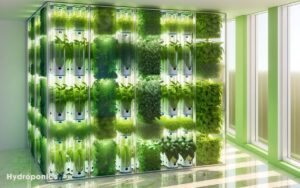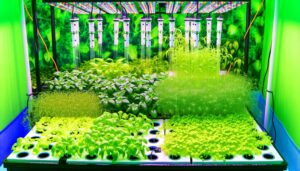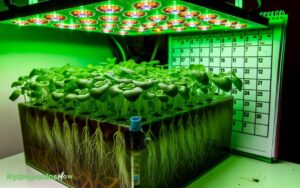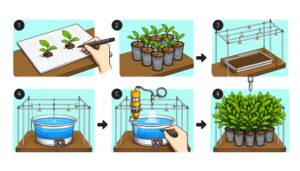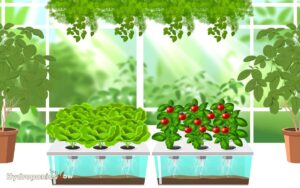Can Plants Grown Hydroponically Be Deemed Organically Grown?
Yes, plants grown hydroponically can be deemed organically grown under certain conditions and regulatory frameworks.
Organic certification depends on the use of primarily natural nutrient sources and adherence to organic pest and disease management methods.
While hydroponic systems lack the soil-based processes traditionally associated with organic farming, they can still meet sustainability and input criteria set by organic standards.
Variations exist among different regions’ certification bodies. Case studies, such as Wholesum Farms, show successful organic certification of hydroponic products.
Understanding this evolving landscape can provide deeper insights into the compatibility of hydroponics with organic principles.

Key Takeaways
Defining Organic Farming
Organic farming, fundamentally, is an agricultural system that emphasizes the use of natural inputs and processes to enhance soil fertility, biodiversity, and ecological balance while minimizing synthetic chemicals and genetically modified organisms (GMOs).
This approach relies heavily on techniques such as crop rotation, green manure, composting, and biological pest control to maintain soil health and prevent pest infestations.
According to the International Federation of Organic Agriculture Movements (IFOAM), organic farming also prioritizes animal welfare and resource recycling.
The avoidance of synthetic pesticides and fertilizers is a cornerstone of this system, aiming to produce food sustainably and safely.
Scientific studies have shown that organic farming can lead to higher biodiversity and improved soil structure, contributing to long-term agricultural productivity and environmental conservation.
Basics of Hydroponic Systems
Hydroponic systems are a method of growing plants without soil, using nutrient-rich water solutions to deliver essential minerals directly to the plant roots. This technique allows for greater control over nutrient levels, leading to faster plant growth and higher yields compared to traditional soil-based cultivation. Among various crops, lettuce is often considered the fastest growing plant in hydroponics, reaching harvestable size in just a few weeks. Additionally, hydroponic systems conserve water more efficiently, making them a sustainable option for modern agriculture.
These systems can be categorized into several types, including nutrient film technique (NFT), deep water culture (DWC), and aeroponics. Each type employs a unique mechanism to guarantee ideal nutrient uptake, oxygenation, and root support.
For instance, NFT involves a shallow stream of nutrient solution flowing over the roots, while DWC submerges roots in oxygenated water. Aeroponics, on the other hand, suspends roots in the air, intermittently misting them with nutrient solutions.
The precision of nutrient delivery in hydroponic systems often leads to faster growth rates, higher yields, and reduced water usage compared to traditional soil-based cultivation.
Soil’s Role in Organic Farming
Soil’s role in organic farming is pivotal due to its nutrient composition and microbial activity. Both factors have a substantial impact on plant health and productivity.
The complex interactions within the soil ecosystem contribute to nutrient cycling, enhancing the availability of essential elements to plants.
Additionally, soil microbial activity fosters plant resilience by promoting disease suppression and improving nutrient uptake.
Soil Nutrient Composition
Nutrient composition in soil plays a critical role in organic farming. It provides essential minerals and elements that support plant growth and ecosystem sustainability.
Soil inherently contains macronutrients such as nitrogen, phosphorus, and potassium, as well as micronutrients like iron, manganese, and zinc. These nutrients are naturally replenished through organic matter decomposition and microbial activity.
Organic farming practices emphasize maintaining and enhancing soil fertility through composting, green manures, and crop rotation. This guarantees a balanced nutrient profile, promoting robust plant development and resilience against pests and diseases.
Unlike synthetic fertilizers used in conventional agriculture, organic amendments release nutrients slowly. This aligns with plant uptake rates and reduces the risk of nutrient leaching and environmental contamination.
Soil Microbial Activity
Microbial activity in soil is essential to organic farming, as it drives the decomposition of organic matter and the cycling of nutrients essential for plant growth.
Soil microorganisms, including bacteria, fungi, and actinomycetes, play a vital role in breaking down organic residues, thereby releasing nutrients in bioavailable forms that plants can absorb.
This symbiotic relationship enhances soil structure, water retention, and disease suppression. According to research, these microbial processes play a key role in the sustainability and productivity of organic farming systems.
In contrast, hydroponically grown plants lack this intricate microbial ecosystem, raising questions about their equivalence to soil-grown organic produce.
Therefore, the absence of soil microbial activity in hydroponic systems challenges their classification under traditional organic farming standards.
Nutrient Sources in Hydroponics
Hydroponic systems rely on a carefully balanced solution of mineral nutrients to support plant growth, as opposed to traditional soil-based methods. These nutrient solutions typically include essential macro and micronutrients, which are important for the best plant health.
The primary sources of nutrients in hydroponics include:
- Commercially Prepared Nutrient Solutions: These are pre-mixed solutions tailored for various stages of plant growth.
- Organic Nutrient Sources: Derived from natural substances like fish emulsion or seaweed extract, they aim to mimic the nutrient profile found in organic soil.
- Customized Nutrient Mixes: Formulated by growers to meet the specific needs of their crops, these mixes ensure precise control over nutrient ratios.
Chemical Use in Hydroponics
While organic nutrient sources provide a natural alternative, the use of chemical additives in hydroponics remains a critical aspect for optimizing plant health and growth.
These chemical additives, such as synthetic fertilizers, micronutrients, and pH adjusters, are meticulously formulated to guarantee precise nutrient delivery.
Studies indicate that these compounds can enhance nutrient uptake efficiency and improve overall plant vigor. However, the reliance on synthetic chemicals raises concerns regarding their compatibility with organic standards.
Rigorous quality control measures are implemented to mitigate potential contaminants and ensure environmental safety.
Despite these controls, the debate continues over whether such practices align with organic principles, particularly concerning sustainability and ecological impact. Therefore, understanding the role and regulation of chemical additives is pivotal in this situation.
Sustainability of Hydroponic Methods
The sustainability of hydroponic methods is primarily assessed through resource efficiency, environmental impact, and water usage.
Hydroponic systems typically require less water compared to traditional soil-based agriculture, thereby presenting a potentially lower environmental footprint.
Additionally, these systems can be optimized to use nutrients more efficiently, reducing waste and promoting sustainable agricultural practices.
Resource Efficiency in Hydroponics
Efficient resource utilization in hydroponic systems greatly enhances sustainability by minimizing water and nutrient waste. Hydroponics employs closed-loop systems that allow for precise control over resource input, leading to remarkable efficiencies.
Studies indicate that hydroponic methods can reduce water usage by up to 90% compared to traditional soil-based agriculture.
Key factors contributing to this efficiency include:
- Recirculation Systems: Water and nutrients are reused, notably reducing the need for fresh inputs.
- Targeted Delivery: Nutrients are supplied directly to plant roots, minimizing loss and enhancing uptake efficiency.
- Controlled Environment: Optimized conditions reduce the need for pesticides and herbicides, further lowering resource consumption.
These attributes underscore hydroponics’ potential for sustainable agricultural practices, emphasizing its strategic role in resource conservation.
Hydroponic Environmental Impact
In addition, hydroponic systems present a lower environmental footprint compared to conventional agriculture due to their reduced water usage and minimal chemical runoff.
Studies indicate that hydroponics can decrease water consumption by up to 90% and eliminate soil erosion, a significant issue in traditional farming.
Additionally, hydroponic methods often utilize closed-loop nutrient delivery systems, effectively minimizing the leakage of fertilizers into surrounding ecosystems. The controlled environment limits the need for pesticides, further reducing toxic residues.
Furthermore, hydroponics can be implemented in urban settings, decreasing transportation emissions and promoting local food production.
These factors collectively contribute to the sustainability of hydroponic methods, positioning them as a viable alternative to conventional agricultural practices in addressing environmental concerns.
Water Usage Comparison
In comparative studies, hydroponic systems demonstrate markedly lower water consumption rates than traditional soil-based agriculture.
This efficiency stems from several key factors:
- Closed-loop systems: Hydroponics employ recirculating water techniques, reducing overall water waste.
- Targeted delivery: Nutrient solutions are delivered directly to plant roots, minimizing evaporation and runoff.
- Reduced soil dependency: Without soil, there’s decreased need for irrigation to maintain soil moisture levels.
These attributes collectively enable hydroponic methods to use up to 90% less water compared to conventional farming. This reduction is critical in regions facing water scarcity or drought conditions.
Biodiversity and Ecosystem Impact
The cultivation of plants using hydroponic methods can greatly influence biodiversity and ecosystem stability by altering habitat structures and nutrient cycles.
Hydroponic systems, often confined to controlled environments, typically reduce the land use footprint compared to traditional farming.
However, this reduction can result in less habitat availability for terrestrial organisms, potentially impacting local biodiversity.
Additionally, hydroponic methods that rely on synthetic nutrients can disrupt natural nutrient cycles, influencing soil and water ecosystems.
Conversely, hydroponics may mitigate some negative impacts of conventional agriculture, such as soil erosion and pesticide runoff.
As a result, the overall effect on biodiversity and ecosystems depends on the specific practices employed and the comparative baseline of conventional agricultural methods.
Further empirical studies are required to thoroughly assess these impacts.
Organic Certification Criteria
Establishing organic certification criteria for hydroponic systems involves rigorous standards to guarantee the use of natural inputs and sustainable practices.
These criteria are designed to make sure that hydroponically grown plants can meet the stringent requirements traditionally applied to soil-based organic farming.
The key components of certification include:
- Nutrient Sources: Nutrient solutions must derive primarily from natural, non-synthetic sources, such as compost teas or fish emulsion.
- Pest and Disease Management: Only allowed organic pesticides and biological controls can be utilized to manage pests and diseases.
- Sustainable Practices: Systems must adopt water conservation methods and renewable energy sources wherever feasible.
These criteria aim to uphold the integrity and environmental benefits associated with organic agriculture, even in a soil-less growing environment.
Regulatory Differences
Despite the established organic certification criteria for hydroponic systems, regulatory differences between countries and certifying bodies create a complex landscape for growers seeking organic certification.
For instance, the United States Department of Agriculture (USDA) permits hydroponically grown plants to be certified organic, while the European Union (EU) does not. This discrepancy can confuse producers and consumers alike.
| Country/Region | Certifying Body | Hydroponics Organic Status |
|---|---|---|
| United States | USDA | Permitted |
| European Union | EU Organic | Not Permitted |
| Canada | Canada Organic | Permitted with Restrictions |
| Japan | JAS | Permitted under Specific Conditions |
Regulatory frameworks vary widely, reflecting differing philosophies on soil health and sustainability. These variations necessitate careful navigation by producers aiming to achieve organic certification across multiple markets.
Case Studies of Organic Hydroponics
Examining successful implementations, several case studies illustrate the viability and challenges of achieving organic certification for hydroponically grown plants.
Key examples include:
- Wholesum Farms: This Arizona-based company achieved USDA Organic certification for its hydroponic tomatoes by adhering to organic nutrient solutions and pest management practices.
- Living Water Farms: Located in Illinois, this facility successfully grew organic leafy greens hydroponically, emphasizing the use of organic seeds and bio-based fertilizers.
- Superior Fresh: This Wisconsin aquaponic farm integrates fish production with hydroponics, utilizing organic fish feed and organic plant nutrients to attain certification.
Each case demonstrates that although organic hydroponics is feasible, it demands stringent adherence to organic standards, innovative nutrient sourcing, and meticulous management practices to align with regulatory requirements.
Consumer Perceptions
Consumer perceptions of hydroponically grown organic plants are influenced by several factors. These include misconceptions about the organic label, trust in certification bodies, and environmental concerns.
Research indicates that some consumers are skeptical about the organic status of hydroponically grown produce. They question its adherence to traditional soil-based organic practices.
Additionally, the credibility of certification agencies plays a pivotal role in shaping consumer trust and acceptance of these products.
Organic Label Misconceptions
A significant misconception among consumers is the belief that the organic label on hydroponically grown plants guarantees soil-based growing methods.
This misunderstanding arises due to several factors:
- Historical Context: Traditionally, organic farming has been associated with soil health and biodiversity, leading consumers to assume soil involvement.
- Label Interpretation: The term ‘organic’ is often equated with natural growing conditions, overlooking the fact that hydroponics can also meet organic standards.
- Marketing Practices: Marketing materials may emphasize organic certification without clarifying the absence of soil, further perpetuating confusion.
The organic label signifies compliance with specific agricultural standards, including the avoidance of synthetic pesticides and fertilizers.
However, it does not inherently denote soil-based cultivation, particularly in hydroponic systems that achieve organic certification through alternative means.
Trust in Certification
Despite robust certification processes, consumer trust in organic labels for hydroponically grown plants varies greatly due to lingering doubts about the equivalency of soil and soilless cultivation methods.
Studies suggest that some consumers perceive hydroponic systems as lacking the natural soil interactions that traditionally define organic farming.
This skepticism challenges certification bodies to transparently communicate the standards and practices that qualify hydroponically grown produce as organic.
Research indicates that clarity about nutrient sources, pest control measures, and environmental impacts is essential to bridge this trust gap.
Certification bodies must thus emphasize rigorous criteria and continuous monitoring to guarantee that hydroponic methods meet organic standards, thereby fostering greater consumer confidence in such labels.
Environmental Concerns
Many consumers express concerns regarding the environmental sustainability of hydroponic systems compared to traditional soil-based organic farming.
Key issues include:
- Water Usage: Hydroponic systems generally use 70-90% less water than conventional farming methods, presenting a more thorough water-efficient alternative.
- Energy Consumption: Hydroponics can require significant energy inputs, primarily for artificial lighting and climate control, potentially offsetting environmental benefits.
- Nutrient Management: The closed-loop systems used in hydroponics minimize nutrient runoff, reducing pollution and promoting more effective nutrient use.
Evidence suggests that while hydroponics presents certain environmental advantages, such as reduced water usage and nutrient management efficiency, concerns about energy consumption remain.
Thorough lifecycle assessments are necessary to fully evaluate the environmental impact of hydroponic versus traditional organic farming systems.
Future of Organic Hydroponics
The future of organic hydroponics relies on advancements in sustainable nutrient sources, innovative system designs, and rigorous regulatory frameworks to guarantee environmental and public health benefits.
Research into organic nutrient formulations derived from plant and animal waste can improve sustainability. Additionally, closed-loop hydroponic systems and aquaponics are being optimized to minimize resource use and waste.
Regulatory bodies must also establish clear standards for organic hydroponic certification to uphold consumer trust and market integrity.
Studies indicate that integrating renewable energy sources, such as solar or wind, can further enhance the eco-friendliness of these systems.
As these technological and regulatory developments converge, organic hydroponics may become a viable, environmentally sound alternative to traditional organic farming.
Conclusion
The debate over whether hydroponically grown plants can be deemed organically grown hinges on several factors:
- the definition of organic farming,
- the role of soil,
- nutrient sources,
- chemical use, and
- regulatory differences.
Case studies illustrate varying practices and perceptions, while consumer attitudes reflect a complex market.
The future of organic hydroponics will likely depend on evolving regulations and scientific advancements, necessitating continued research and dialogue within the agricultural community to reach a consensus.

